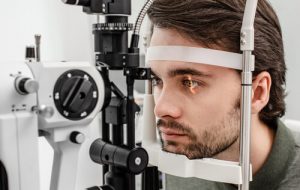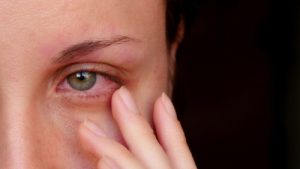Have you ever noticed those pesky red squiggly lines in your eyes, seemingly appearing out of nowhere? Don’t worry, as you’re not alone. These tiny crimson vessels can be problematic, but knowing the causes is the first step toward finding relief.
In this article, we’ll explore the factors behind the appearance of those red squiggly lines in your eyes and shed light on what you can do to restore clarity and comfort to your vision. So, let’s dive into the fascinating world of ocular glitches and discover what lies behind those curious red, squiggly lines in the eyes.
Red Squiggly Lines: An Overview of Subconjunctival Hemorrhage
Subconjunctival hemorrhage, often observed as red squiggly lines in the eyes, is a condition where tiny normal blood vessels break beneath the eye’s surface, the blood vessel leading to a noticeable red spot. Understanding this condition is necessary for recognizing its symptoms and knowing when to seek the doctor.
Symptoms Beyond Redness:
Typically, the only symptom is a red or bloodshot appearance in one part of the eye. Unlike other eye conditions, subconjunctival hemorrhage usually doesn’t cause pain, blurry vision, or discharge.
Factors Contributing to Vessel Breakage:
Common factors include excessive straining, coughing, heavy lifting, or eye rubbing. In some cases, it can be related to blood-thinning medications or blood clotting disorders.
Distinguishing from Other Eye Conditions:
It’s important to differentiate subconjunctival hemorrhage from conditions like pink eye or eye infections, with additional symptoms like itchiness, discharge, or vision problems.
When to Seek Medical Attention:
Consult an eye doctor if you experience accompanying symptoms like eye pain, permanent vision loss, or persistent redness. An eye exam can reveal out more serious conditions.
Treatment and Management:
Most cases of subconjunctival hemorrhage resolve without treatment within a couple of weeks. For symptomatic relief, cold compresses and artificial tears can be helpful.
Preventive Measures:
To prevent future occurrences, protective measures include using eye protection, managing blood pressure, and reducing eye strain from extended screen time.
Common Causes of Redness in the Eyes: From Fatigue to Allergies

Redness in the eyes, a common visual symptom, can be caused by different factors including fatigue to allergies. This symptom is typically marked by dilated blood vessels on the eye’s surface, giving the white part of red eyes a reddish appearance. Understanding these common causes is essential for effective management and treatment.
- Fatigue and Eye Strain: Extended periods of screen time or intense focus on any activity can lead to eye fatigue, causing the eyes to become red and irritated. The use of digital devices often exacerbates this due to increased exposure to blue light.
- Allergies: Allergic reactions from pollen, pet dander, or dust can lead to red, itchy, and watery eyes. The body’s immune response to these allergens dilates blood vessels, resulting in redness.
- Dry Eye Syndrome: Chronic dryness of the eyes, often due to environmental factors like dry air or prolonged use of contact lenses, can lead to irritation and redness. The lack of adequate lubrication on the eye surface aggravates this condition.
- Infections: Eye infections like conjunctivitis (pink eye) or blepharitis can cause red eyes. These infections are characterized by inflammation of different eye parts, often accompanied by other symptoms like discharge or pain.
- Environmental Irritants: Exposure to smoke, chlorine in swimming pools, or other environmental chemicals can irritate the eyes, leading to redness and discomfort.
- Contact Lens Wear: Overuse or improper care of contact lenses can cause redness and irritation. Contact lenses lower the amount of oxygen reaching the cornea, leading to redness and potential damage.
- Other Medical Conditions: Certain conditions, such as autoimmune diseases or hypertension, can manifest eye symptoms, including redness.
Treatment Options and Remedies for Red Squiggly Lines in Eyes
Treating red squiggly lines in the eyes, typically a symptom of subconjunctival hemorrhage, often centers around alleviating discomfort and addressing underlying causes of eye discharge. While these red lines usually resolve without extensive treatment, understanding the available options and remedies can provide reassurance and expedite recovery.
- Observation and Natural Healing: In many cases, the primary approach is observation, as the body naturally heals a subconjunctival hemorrhage. The broken blood vessels usually repair themselves, and the eye redness dissipates within one to two weeks.
- Cold Compress: For immediate relief, especially if the eye feels irritated or uncomfortable, a cold compress can reduce swelling and provide comfort.
- Artificial Tears: If dryness or a scratchy feeling accompanies the redness, over-the-counter artificial tears can help. These lubricating eye drops soothe and moisturize the dry eyes’ surface.
- Managing Blood Pressure: Since high blood pressure can sometimes cause these blood vessels to burst, maintaining a healthy blood pressure through following diet, exercise, and medication, if prescribed, is beneficial.
- Protecting the Eyes: Preventive measures are crucial, such as wearing protective eyewear during activities that could harm the eyes. Avoiding rubbing the eyes can also reduce the risk of breaking tiny blood vessels.
- Avoid Blood-Thinning Medications: If a doctor advises, limiting the use of certain medications that thin the blood, such as aspirin or warfarin, may prevent future occurrences.
- Seeking Medical Attention: If the redness persists, worsens, or is accompanied by other symptoms such as pain, vision loss, or light sensitivity, it is important to seek medical attention. An eye doctor can assess for more serious conditions or underlying causes.
When to Seek Medical Advice for Persistent Red Eye Symptoms

Persistent red eye symptoms can sometimes indicate an underlying cause or health issues that require medical attention. Recognizing when to consult a healthcare professional is crucial for proper diagnosis and treatment, ensuring your eyes’ health and overall well-being.
- Changes in Vision: If redness is accompanied by vision changes such as blurred vision, vision loss, or increased sensitivity to light, it is essential to seek immediate medical attention. These symptoms could indicate more serious conditions like glaucoma or a corneal ulcer.
- Pain in the Eye: Red eyes with persistent or severe pain are not typical and warrant a visit to an eye doctor. Pain can indicate an eye infection, inflammation, or injury.
- Persistent Redness: A professional should evaluate redness that does not improve or worsens over time, especially after a week or more. Chronic red eye could be a symptom of ongoing conditions like dry eye syndrome or chronic uveitis.
- Accompanying Symptoms: Additional symptoms such as discharge, swelling, a feeling of something in the eye, or constant tearing are reasons to seek medical advice, as they could indicate infections like conjunctivitis or more serious issues like an eye ulcer.
- Contact Lens Wearers: Those who wear contact lenses and experience red eyes should consult a doctor, as this can be a sign of a contact lens-related infection or corneal problem.
- Pre-Existing Health Conditions: Individuals with pre-existing health conditions like diabetes or autoimmune diseases should be more cautious with eye symptoms, as these conditions can lead to more complex eye issues.
- Unexplained Headaches: If unexplained headaches or migraines accompany red eye, it’s important to seek medical advice, as this combination of symptoms can be related to ocular or neurological conditions.
In conclusion, red squiggly lines in the eyes can be attributed to various factors. These may include dryness, allergies, eye strain, or underlying health conditions. Contact lens wear and excessive use of digital screens without breaks can also contribute to this issue. It is important to consult with an eye care professional if you experience persistent or severe red squiggly lines in your eyes, as they can provide a proper diagnosis of common eye conditions and recommend appropriate treatment. Regular breaks, good eye hygiene, wearing protective eyewear, and maintaining overall eye health are essential to prevent and reduce the appearance of these red squiggly lines.
References
MedlinePlus – Red blood cell count
https://medlineplus.gov/ency/article/003031.htm
Stack Overflow – Red squiggly lines in VS Code
https://stackoverflow.com/questions/63419399/red-squiggly-lines-in-vs-code
All About Vision – Red Eyes
https://www.allaboutvision.com/conditions/red-eyes.htm
National Eye Institute (NEI) – Uveitis
https://www.nei.nih.gov/learn-about-eye-health/eye-conditions-and-diseases/uveitis
American Academy of Ophthalmology (AAO) – Bright wavy lines in vision
https://www.aao.org/eye-health/ask-ophthalmologist-q/bright-wavy-lines-vision

